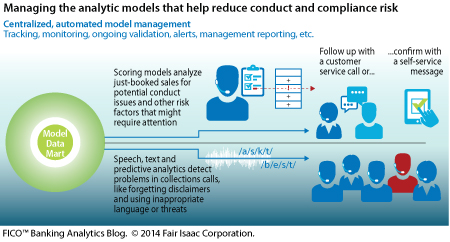Customer Centricity Success Story: Reducing Compliance Risk
Recently on the blog, I shared stories of two FICO clients (Bank A and Bank B) that are successfully overcoming challenges to advance customer centricity goals. Today I’ll share th…

Recently on the blog, I shared stories of two FICO clients (Bank A and Bank B) that are successfully overcoming challenges to advance customer centricity goals. Today I’ll share the story of a third client, which I'll refer to as Bank C.
Bank C, like many others in its markets, was fined by regulators for misconduct in selling fee-based extra services to new accountholders. Moreover, the light shined on this problem made it clear that over-zealous sales activities weren’t the institution’s only vulnerability to fines and reputational damage from regulatory noncompliance.
Bank C executives began asking questions such as: Are automated originations processes confirming that customers understand and accept product and credit terms? Are collections agents making the required disclaimers at the proper time in the conversation, and avoiding using inappropriate language and threats? The answers convinced them the bank needed to put in place policies, systems and processes to provide better visibility into and controls over compliance risk exposure.
As part of this solution, Bank C deployed analytic models to score new sales for compliance risk. The objective was to identify potential high-risk cases for review and follow up with the customer. To improve efficiency, the bank got started by working with FICO to implement an automated scoring service across a number of different product lines, including credit, savings and insurance.
But in such a dynamic market, where regulations, bank products and customer behavior are all changing, how could the bank ensure that the deployed models continued to accurately identify the risk level of these sales? Factors indicative of high risk today might not be significant a few months from now, and vice versa.
The solution was to also implement centralized, automated model management, illustrated below. Regularly scheduled model validation processes will fully document analytic performance, generate alerts when it drops below specified thresholds and even capture actions taken in response to validation findings. An accompanying model development environment will allow the compliance risk models to be quickly refreshed and deployed back into the scoring service. This framework also has the potential to support other conduct risk assessments, such as those used for collections calls.
To read other customer centricity success stories, I invite you to download our new Insights white paper: “Customer Centricity: Four Bank Success Stories” (No 78; login required).
Popular Posts

Business and IT Alignment is Critical to Your AI Success
These are the five pillars that can unite business and IT goals and convert artificial intelligence into measurable value — fast
Read more
Average U.S. FICO Score at 717 as More Consumers Face Financial Headwinds
Outlier or Start of a New Credit Score Trend?
Read more
FICO® Score 10T Decisively Beats VantageScore 4.0 on Predictability
An analysis by FICO data scientists has found that FICO Score 10T significantly outperforms VantageScore 4.0 in mortgage origination predictive power.
Read moreTake the next step
Connect with FICO for answers to all your product and solution questions. Interested in becoming a business partner? Contact us to learn more. We look forward to hearing from you.

